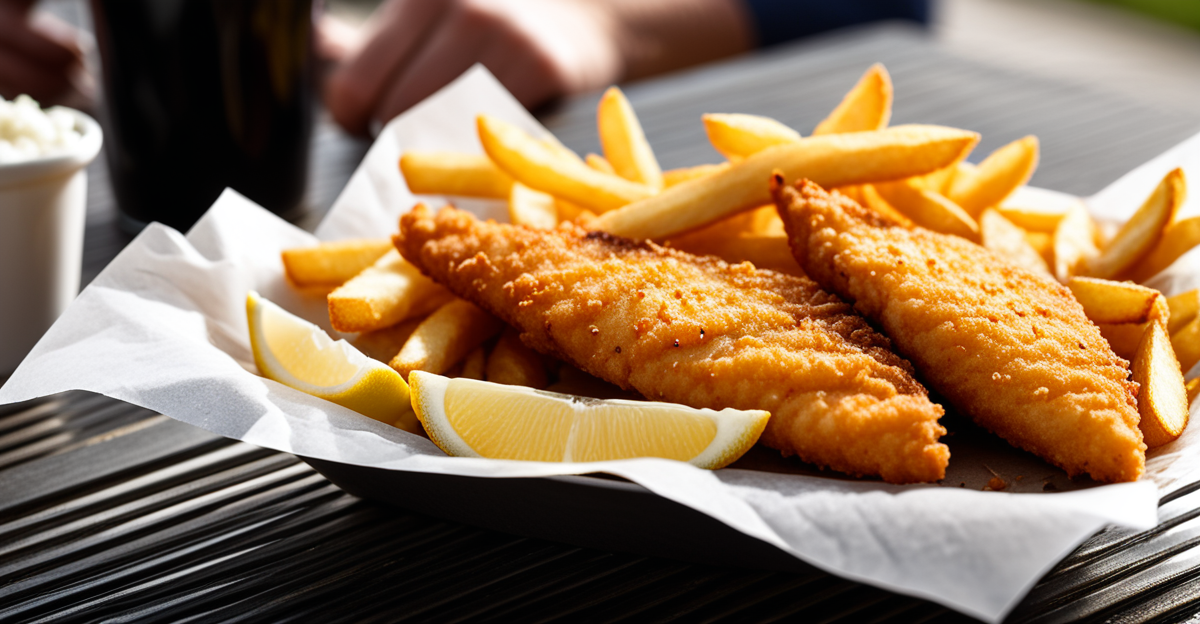Essential Batter Techniques for Crispy Fish
Mastering the fish and chips batter is key to achieving that perfect crispy fish coating loved by many. The choice of flour significantly affects the texture; using plain wheat flour or a mix with rice flour can yield a crisper finish. Rice flour, for instance, lends a lighter, crunchier crust compared to all-purpose flour, which can be denser.
Consistency plays a vital role in creating a batter that’s light and airy yet adheres well to the fish. A batter that’s too thick results in a heavy coating, while one that’s too thin might slide off during frying. Aim for a smooth batter that lightly coats the fish, resembling the consistency of heavy cream.
In parallel : What are the must-try regional specialties in UK cuisine?
To elevate crispiness, adding carbonation enhances the batter’s texture. Ingredients like sparkling water or beer introduce bubbles, making the coating fluffier and less dense. Alternatively, small amounts of alcohol such as vodka or gin work similarly by reducing gluten formation, ensuring a more delicate crust.
In summary, the critical factors for an ideal fish and chips batter include:
This might interest you : How can you create a savory steak and kidney pie at home?
- Selecting the right flour blend for crisp texture
- Achieving a batter consistency that balances adherence and lightness
- Incorporating carbonation or alcohol for extra crunch and airy coating
Careful attention to these techniques ensures a crispy fish coating that remains crisp after frying, delivering the satisfying crunch expected from a classic fish and chips experience.
Oil Temperature and Frying Methods
Maintaining the correct oil temperature is crucial when frying fish and chips to achieve a perfectly crispy outcome. The ideal range typically falls between 175°C and 190°C (347°F to 374°F). Frying at too low a temperature causes the batter to absorb excess oil, leading to a greasy, soggy texture rather than a crisp coating. Conversely, too high a temperature can burn the batter’s exterior before the fish cooks through.
Choosing the right oil impacts both flavor and crispiness. Neutral oils with high smoke points like vegetable oil, sunflower oil, or peanut oil are preferred. These oils withstand the necessary frying temperatures without breaking down, ensuring a consistent, crunchy fish and chips result.
Monitoring oil temperature with a reliable thermometer helps maintain optimal heat, especially during batch frying. When adding multiple pieces, the oil temperature naturally drops. To counter this, fry in small batches, allowing the oil to recover to the target temperature between batches. This prevents sogginess caused by overcrowding and uneven cooking—a common mistake in frying fish and chips.
In summary, follow these frying tips for a superior crispy fish coating:
- Use high smoke point oils like vegetable or peanut oil.
- Maintain the oil temperature consistently between 175°C and 190°C.
- Avoid overcrowding the fryer by batch frying small amounts at a time.
Implementing these strategies safeguards the integrity of the crispy batter and ensures golden, crunchy fish and chips every time.
Preparing Fish for Maximum Flakiness
Selecting the right fish is fundamental when preparing for a flaky, tender bite beneath your crispy fish coating. Fresh, firm white fish varieties such as cod, haddock, or pollock are preferred thanks to their mild flavor and flaky texture. These types hold up well during frying, delivering the ideal contrast between flaky interior and crisp exterior.
Proper preparation begins with thorough drying of the fillets. Excess moisture prevents the batter from adhering well and can cause steam during frying, resulting in a soggy rather than crispy fish. Pat the fillets dry with paper towels before seasoning. Seasoning at this stage enhances the natural flavor and contributes to a well-rounded taste in every bite.
Cutting fillets into even portions ensures uniform cooking. Uneven thickness leads to either undercooked centers or overcooked edges, neither of which complements the delicate fish and chips batter. Aim for consistent size and thickness to synchronize cooking times and maintain the perfect texture throughout.
In summary, mastering fish preparation for flaky results involves:
- Choosing fresh, firm white fish varieties suited to frying
- Thoroughly drying and seasoning fillets before battering
- Cutting fillets evenly for consistent cooking results
This careful attention to fish selection and prep complements the batter and frying techniques, culminating in a superior crispy fish coating and satisfying meal.
Perfecting Chips: Crisp on the Outside, Fluffy Inside
Achieving the ideal crispy chips involves a precise process that balances texture and taste. The foundation starts with selecting the right potato, preferably starchy varieties like Maris Piper or Russets, which produce fluffy interiors while forming crisp exteriors after frying.
Blanching the potatoes before frying is crucial for fluffiness. This involves par-cooking the cut chips in hot water or oil at a lower temperature to soften the starch inside without browning. Blanching sets the structure, preventing sogginess during the final fry and ensuring a soft, tender inside.
The double frying technique is widely regarded as the best method to get lasting crunch. First, chips are fried at a moderate temperature (around 150°C) to cook through, then drained and rested. The second fry, at a higher temperature (around 190°C), crisps up the exterior rapidly without overcooking the interior. This two-step method locks in moisture and creates the coveted crispness.
After frying, proper draining and seasoning play a significant role. Draining excess oil on a wire rack or paper towel prevents oiliness that can weigh down the crispy chips. Applying salt or seasoning immediately after frying allows it to stick better, enhancing flavor without compromising texture.
To summarize key points for perfect homemade fries:
- Select starchy potatoes such as Maris Piper or Russets for ideal texture
- Blanch cut chips to soften the interior and reduce moisture during the final fry
- Employ double frying—first at low, then high temperature—for maximum crispiness
- Drain thoroughly and season while chips are hot to maintain flavor and crunch
This combination of techniques ensures crispy chips that are fluffy inside and delightfully crunchy outside, elevating any fish and chips meal.
Tricks to Keep Fish and Chips Crunchy After Cooking
Ensuring your fish and chips batter stays crisp after frying requires deliberate techniques in draining, resting, and serving. First, once the fish and chips are removed from the hot oil, immediate and effective draining is critical. Using a wire rack rather than paper towels is preferable, as it allows excess oil to drip away without trapping steam underneath. This prevents moisture buildup that softens the crispy fish coating.
Resting the fried items at room temperature rather than covering them helps maintain their texture. Covering traps steam, which causes sogginess. Instead, keep the fish and chips uncovered on a wire rack or similar ventilated surface until served. This airing technique ensures moisture disperses instead of condensing on the batter or chips.
When it comes to storing leftovers, avoid airtight containers that create humidity. Instead, use containers that allow some airflow or reheat promptly. For reheating, employ an oven or air fryer at a high temperature (about 180°C) to restore crunchiness without further oil absorption. Microwave reheating is discouraged as it encourages sogginess by steaming the batter.
Key points for keeping fish crispy include:
- Draining fried fish and chips on wire racks to prevent steam moisture
- Resting uncovered to allow moisture escape
- Storing in ventilated containers for short-term freshness
- Reheating quickly using dry heat methods like ovens or air fryers
Applying these practical steps ensures your crispy fish coating and crispy chips maintain their satisfying crunch, elevating the enjoyment of your fish and chips long after cooking.
Expert Advice: Common Pitfalls and Troubleshooting
Common cooking mistakes in frying fish and chips often stem from overcrowding the fryer, which leads to a drop in oil temperature and uneven cooking. When too many pieces are added simultaneously, the oil cools, causing the batter to absorb excess oil and resulting in a soggy, greasy coating rather than the desired crispy fish coating. The batter can also separate or slip off the fish due to insufficient oil heat.
Another frequent issue is improper batter preparation or application. A batter too thick or too thin negatively affects texture and adherence. Thick batter can become heavy and absorb too much oil, while thin batter may fail to stick, exposing fish surfaces and leading to uneven crispiness. Monitoring the batter consistency during preparation can prevent these problems, ensuring a light, airy finish.
Soggy chips typically arise from skipping key steps like blanching or inadequate draining. Blanching removes excess starch and partially cooks potatoes, crucial for achieving crispy chips with fluffy interiors. Neglecting this step causes chips to stay greasy and limp after frying. Likewise, failure to drain properly after frying traps moisture, softening both chips and fish batter.
Troubleshooting tips include:
- Fry in small batches to maintain steady oil temperature and avoid overcrowding
- Adjust batter thickness for a balanced adherence and crunch
- Always blanch potatoes and drain fried items thoroughly on wire racks to prevent sogginess
Following these expert tips helps prevent common pitfalls, ensuring your fish and chips display the ideal crispy fish coating and perfect chip texture every time.










